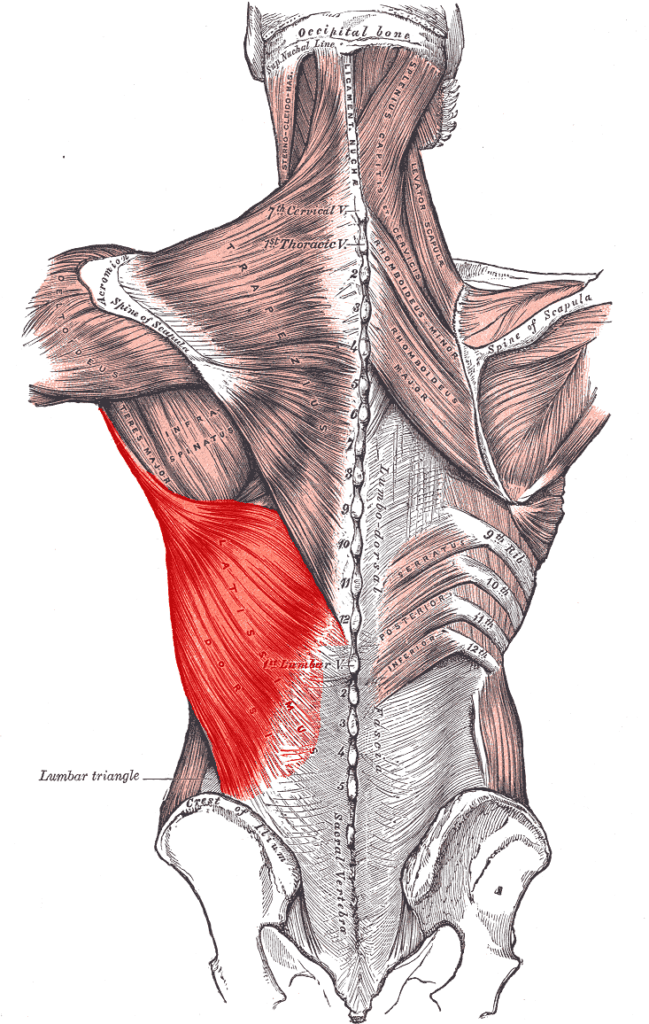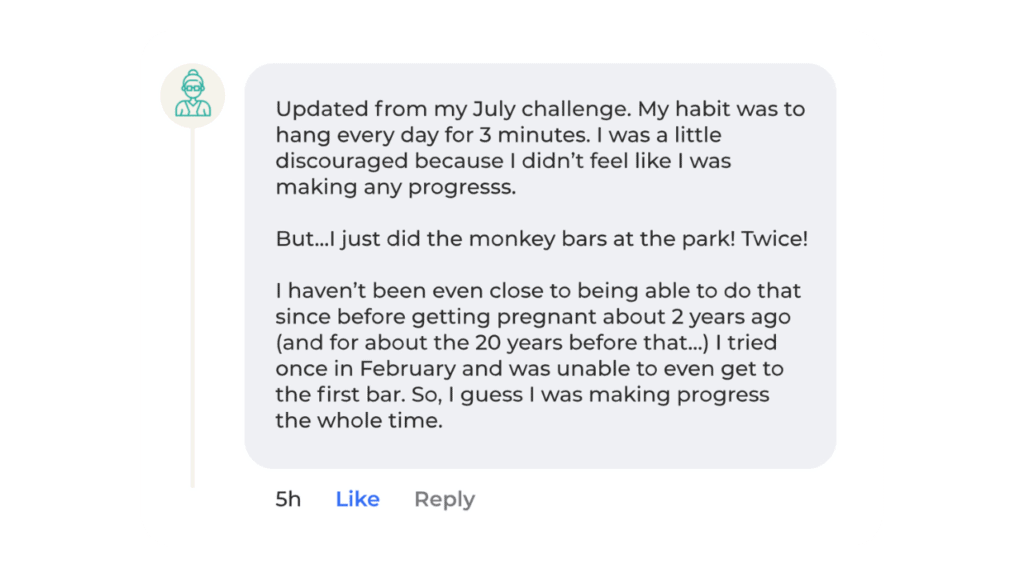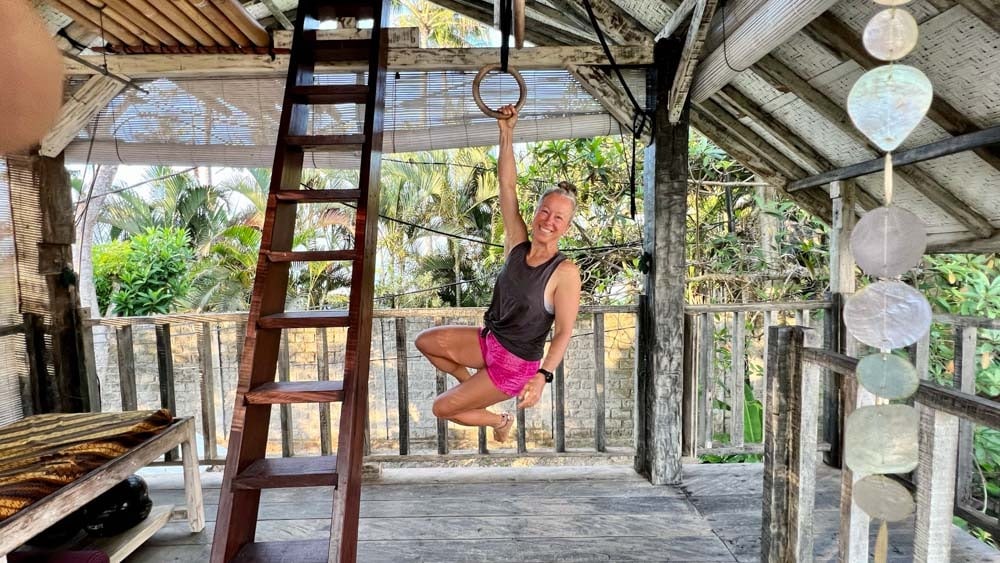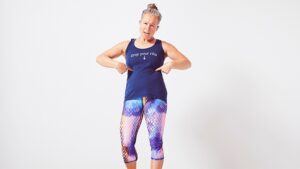The other day I posted a picture to my Instagram that showed me doing a dead-hang from a tree branch on one of our hikes.
And I got a comment from a person who asked why I’m so into hanging. She said she’d seen lots of movement people post hanging pix, but didn’t know why.
Obviously, hanging looks cool on Instagram. But that’s not actually why I do it.
There are lots and lots of reasons to hang, but they all basically boil down to this: hanging is really, really good for you. In fact, I consider it to be one of the major movement ‘macronutrients’ – like fat, carbs or protein, but the movement version.
In today’s post, I’m sharing 9+ reasons that hanging is super important for humans!
So What Is Hanging, Anyway?
‘Hanging’ is maybe not the best word for what I’m talking about today – I just don’t know a better one.
By ‘hanging’ I basically mean ‘Movements that involve suspending your body from a bar or a branch.’
The category includes ‘hanging with your feet on the ground’, ‘hanging with your feet off the ground’, ‘single armed hanging’, ‘swinging side to side’, ‘swinging forward and back’, ‘sideways traversing’, and ‘swinging from bar to bar’ – and a bunch of other variations.
They’re all amazing for your body, as long as they aren’t too much for the current state of your tissues.
It’s safest and best to start with hanging (feet on the ground) because most of us aren’t strong enough to swing around like a monkey – but swinging and climbing are great end-goals.
Here’s 9 reasons you should seriously consider adding some hanging to your day, every day.
#1 Hanging Counteracts Screen Time
In today’s modern lives, most of us spend a lot of time using computers and phones. Like, maybe 8+ hours a day.
This translates to a huuuuuuge amount of repetitive positioning for our arms and shoulders – and not a lot of muscle use or loading.
The result – over the long term – is weakness and often chronic injuries.
So in my book, anything that creates varied shoulder movement and loads your upper body muscles, tissues and joints is a win. And hanging is a really simple way to get overhead movement and loading. Boom!
#2 Hanging Increases Bone Density In Your Wrists
A lot of time when we fall as older adults, we break bones: typically wrists, hips or ribs.
And that’s because after years of minimal movement, our bones lose their density.
Calcium and Vitamin D play a role in bone building for sure, but my bet is that movement is the bigger deal.
Why? Because we typically lose bone density in specific areas, not globally – which is a major clue that it’s not just the system that’s the problem. Bone is built and reinforced when it is loaded – so if you aren’t exposing your bone-cells to movements that squish them and pull them, they won’t get beefed up. It’s a lot like weightlifting – when you expose your body to stressors, it adapts by becoming stronger.
The good news is that hanging is an amazing way to improve bone density in the wrists! When the bone cells in your wrist get tugged on by your body weight, you create a tensile load that signals your wrist bones to increase their mass. It’s literally a weight-bearing exercise that specifically targets one of the areas we need it the most.
#3 Improve Your Grip Strength
Did you know that your grip strength correlates to life expectancy, heart health and health-related quality of life?
I suspect this is because grip strength also indicates that you move a lot – not because strong hands in and of themselves are a huge health asset.
Buuuut you know what increases both upper body strength AND grip strength?
If you guessed ‘hanging’, you’d be right 🙂
In fact, most people find that their hands are their weakest link when they get on the bars. By creating a regular hanging practice, you’ll definitely notice that your grip strength improves – along with everything else.
#4 Hanging Helps You Find Your Lats
When you hang with good technique, you’ll have to engage your lats – giant muscles that wrap from your shoulders to pelvis, via your lower back. Because they’re so big, this basically means that what you are doing with your lats has a major impact on your shoulders, neck, pelvic floor and core function. Because of modern sedentary habits, our lats are often underused and undermoved.
Functional lats contribute to shoulder stability (awesome). They help you banish neck and shoulder tension. And they contribute to core function and strength. So these are muscles you DEFINITELY want to be working for you!
As you hang more, you’ll naturally start connecting more and more to your lats and you’ll get to enjoy the benefits of waking up these huge and important muscles!

#5 Hanging Uses Serious Core Strength
Now that your lats are working, your core and trunk muscles are going to get worked too. Hanging with good technique is an incredible functional core exercise.
Good hanging technique includes keeping your ribs down while you hang. Lifting up the rib cage is a common compensation for tight, weak shoulders – and for missing core stability. Rib-lifting isn’t great for your spine or core – so most of us benefit from hanging with our arms slightly in front of us, doing a bit of an ab crunch or ‘hollow body’ – and voila! Stronger core muscles!
(Not sure what ‘ribs down’ means in your body? Grab my free Ribcage Magic video series and start learning!)
#6 Hanging Can Decrease Shoulder Pain, Improve Shoulder Mobility And May Help Many Chronic Shoulder Issues
Modern shoulders can hurt! Osteoarthritis, shoulder impingement, frozen shoulder and rotator cuff tears are common issues that can be helped by a careful hanging program.
There’s a short book that might interest you by Dr. John Kirsch that explains the anatomy and reasoning behind how hanging helps shoulder issues – you can read reviews right here. He gets a bit technical – I prefer to think of hanging loads being something our bodies have been missing for most of their lives – but no matter how you think about it, it seems like hanging can help decrease shoulder pain for many people.
Just like you need to get Vitamin C so that your body works right, you also need Vitamin Hanging!
Although hanging itself can help mobilize your shoulders, many of us will benefit from doing extra shoulder mobility work as part of our hanging progression. But that’s ok – it’s all a journey, and you need to work where your unique body is at if you want to make helpful changes.
Here’s one of my favourite exercises to help get you started improving the range of motion in your shoulders. It’s also super fun!
#7 Hanging Can Help You Breathe Better
After years of not using your upper body very much, all your connective tissues can become dense and stuck together.
Hanging starts to unstick your fascia, muscles and joints so that your entire upper body can work in better alignment.
This frees up precious room for your ribs to move and your lungs to expand.
Breathing is #1 when it comes to your body’s own health priorities – way more important than food and sleep and even other types of movement. So it’s a good thing to work on! Hanging can mobilize, strengthen and reshape your upper body to support the ultra-important task of breathing.
Want more breathing info? Here’s the lowdown on what great breathing technique means.
#8 Create More Movement Variety
Not only do we use our arms and shoulders in limited positions, we also use them mostly for pushing-type movements.
Pulling-type movements are a whole new type of load – and a load that your body needs, because it needs ALL the loads.
Just like you wouldn’t only eat one type of food and then expect to be healthy, you need to make sure your movement diet is full of variety. Hanging is an excellent way to instantly enrich your movement diet with pulling, reaching and loading your upper body from your fingers to your spine with a movement nutrient you might be missing!
#9 Hanging Feels Great And It’s Super Fun!
I don’t know about you, but I succeed best at doing things I like.
And it just happens that hanging is super delightful!
Hanging feels amazing on your shoulders, trunk and back, even just hanging with your feet on the ground.
And as you get better, you’ll amaze yourself with what you can do!
It’s seriously satisfying to do your first pull-up (since you were 8) or to swing across the monkey bars for the first time! There’s just something intrinsically rewarding about hanging. I bet you’re going to love it!

Major Bonus: Hanging Can Transform Your Upper Body Alignment & Posture
We all know that it’s not cool to have a hunched upper back and shoulders that sit way forward. That’s super bad posture – and it’s super bad alignment too. In other words, it creates a situation where your body is not functioning at its best. That’s because the way the bones and joints of your upper body are positioned greatly affects their function.
For instance, if your upper back is too curved forward (known as hyperkyphosis) your shoulder blades won’t have the full ability to do their job.
And as I’ve noted above, wonky upper body alignment also impacts important life processes such as breathing.
When you hang regularly, the loads created by hanging can help move your shoulders and upper back into better alignment. Hanging is pretty much the BEST (and maybe only) way to get your shoulder joints back where they belong, because pulling your shoulders back only hides the problem.
Ok, I’m Convinced! How Do I Start Hanging?!
It’s not rocket science to start hanging from bars, but it’s definitely best to take things slowly and carefully if you haven’t been on a monkey bar in a few years. Here’s a blog post with a step by step guide to get you started hanging TODAY!
My Ribcage Magic video series is another great place to start. Many people are surprised when I tell them that the position of your ribcage greatly affects your ability to hang. Rib thrusting can alter your alignment and put big pressure on your core & spine – that’s only worsened when you hang. So it’s important to be able to control your ribcage position when you start hanging.
Grab my Ribcage Magic series so you can learn how to assess your current ribcage position and get tips and exercises so you can get starting hanging the right way! (And if you’re looking for even more great hanging exercises – my Pelvic Floor+ Upper Body program has all the hanging prep work you could ever need!)







